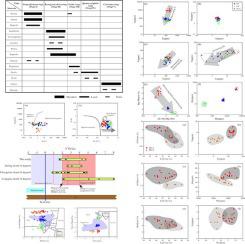当前位置:
X-MOL 学术
›
Ore Geol. Rev.
›
论文详情
Our official English website, www.x-mol.net, welcomes your
feedback! (Note: you will need to create a separate account there.)
The geology, magnetite geochemistry, and oxygen isotopic composition of the Akesayi skarn iron deposit, Western Kunlun Orogenic Belt, Xinjiang, northwest China: Implications for ore genesis
Ore Geology Reviews ( IF 3.2 ) Pub Date : 2021-03-01 , DOI: 10.1016/j.oregeorev.2020.103854 Rui Dong , He Wang , Wenqian Li , Qing-He Yan , Xiaoyu Zhang
Ore Geology Reviews ( IF 3.2 ) Pub Date : 2021-03-01 , DOI: 10.1016/j.oregeorev.2020.103854 Rui Dong , He Wang , Wenqian Li , Qing-He Yan , Xiaoyu Zhang

|
Abstract The Akesayi skarn iron (Fe) deposit is hosted by the Huangyangling Group within the Tianshuihai Terrane of the Western Kunlun orogenic belt, Xinjiang, China, and consists of several orebodies that formed along contacts between Miocene syenogranite, diorite porphyry dykes and late Paleozoic carbonate rocks. Manganese-bearing skarn minerals are common within the deposit. The ore-forming process can be divided into five stages: Prograde skarn stage (I), retrograde skarn stage (II), oxide stage (III), quartz-sulfide stage (IV), and carbonate stage (V), with this evolution being typical of Fe skarns. Magnetite, which formed mainly during the retrograde skarn and oxide stages, includes banded (BO), disseminated (DO), and massive (MO) magnetite. Backscattered-electron images indicate that magnetite within the massive ores can be further classified as primary (MO-1) and secondary (MO-2) magnetite. Magnetite within all ore types exhibits a strongly negative correlation between Si and Fe3+ contents, indicating that Si was incorporated into intra-crystalline sites of magnetite by substitution of Si4+ for Fe3+. Positive correlation among Al, Mn, Mg, and Si contents indicate that these elements behaved similarly during magnetite formation. The δ18OV-SMOW values of MO-1 magnetite range from 4.3‰ to 4.7‰, higher than magmatic magnetite (1‰-4‰), while the BO and DO magnetite have lower δ18OV-SMOW values of 1.7‰ to 2.4‰ and 1.8‰ to 2.5‰ respectively. Its anomalous oxygen isotopic composition indicates that most magnetite in the Akesayi Fe deposit precipitated from evolved ore-forming fluids formed by reaction between country rocks and primary magmatic fluids during the early stages of mineralization, with input from meteoric water during the later stages of mineralization. Trace-element patterns indicate that the different types of magnetite share a common source, with variations in the magnetite geochemistry amongst the different ore types of the Akesayi Fe deposit reflecting variations in the extent of fluid-rock interaction, dissolution-reprecipitation, mineral precipitation, temperature, and oxygen fugacity (ƒO2). The different types of magnetite of the Akesayi skarn Fe deposit form distinguishable populations in (Ca+Al+Mn)-(Ti+V) and (Ni/(Cr+Mn))-(Ti+V) discrimination diagrams, with the range of compositions possibly indicating more variable magnetite compositions in skarn deposits than previously thought.
更新日期:2021-03-01













































 京公网安备 11010802027423号
京公网安备 11010802027423号